The technology that makes Subaru different: enjoyment and peace of mind
Our goals in using AI technology
The Subaru Global Platform is a core Subaru technology to support enjoyment and peace of mind. We believe that our next pillar of this “enjoyment and peace of mind” is the fusion of this Subaru Global Platform and AI technologies. With this pillar, we can monitor the state of drivers, correct their perception, judgment, and control, and mitigate damages in case of accidents with AI. We further evolve “enjoyment and peace of mind” and elevate the identity of Subaru difference.
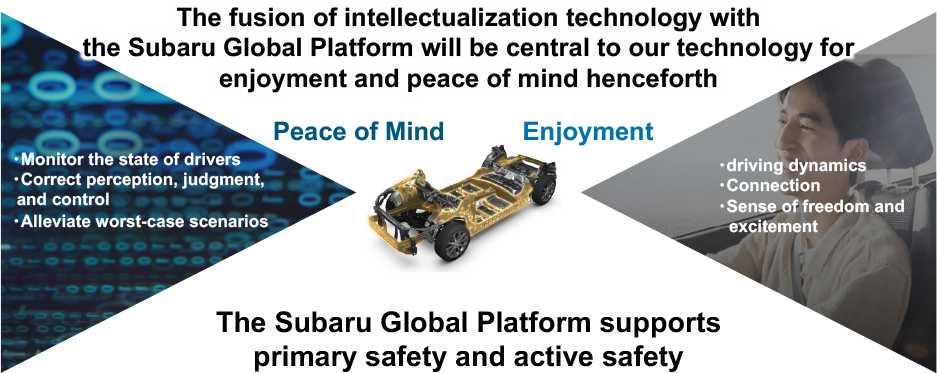
Driving dynamics
We continue to thoroughly dedicate ourselves to the driving dynamics, which can be considered a fundamental performance of vehicles. What we aim for is to realize “vehicles that anyone can easily control as intended under any type of road environments.” AWD has been a technical specialty of Subaru since the launch of Leone estate van in 1972. Our AWD technology is meant to allow anyone to drive like a skilled driver.
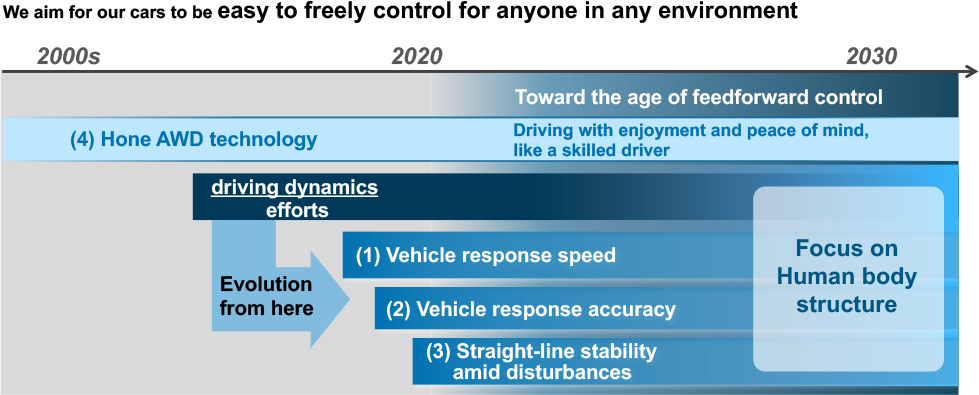
Driving dynamics concept has been incorporated into the Subaru Global Platform since 2016, but we plan to evolve them further.
There are three key points involved: response speed, response accuracy, and straight-line stability. We also focus on human body structure in our vehicle development. We aim to obtain results that every driver can feel the difference with the evolved driving dynamics and believe that driving dynamics are also important for automated driving as a basic performance of vehicle takes a significant role in it.
We will further refine driving with enjoyment and peace of mind with AI technologies.
Vehicle response speed and accuracy
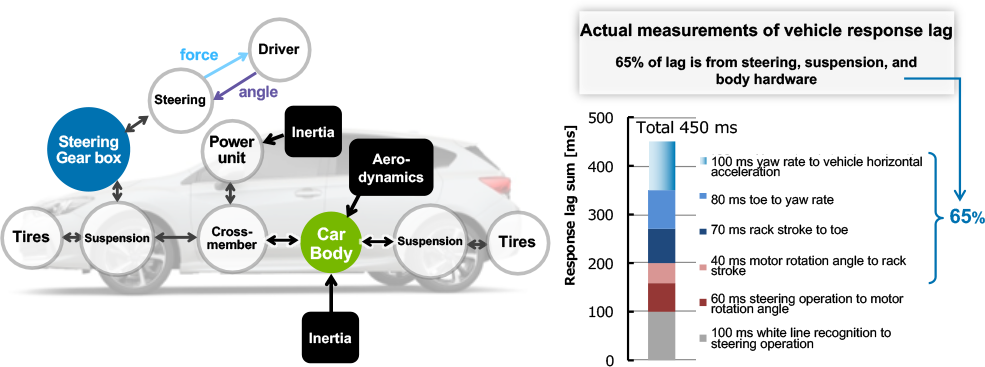
Response speed makes a big difference in ease of driving, therefore Subaru has been putting a lot of effort into it. All of the components affect response speed, from steering and suspension to body and tires. For example, if we assume that there are 0.45 seconds of response lag after the driver turns the steering wheel until the car’s behavior actually changes, 65 percent of the lag is caused by the hardware. We have been improving such response lag with Subaru Global Platform by thoroughly investigating all areas.
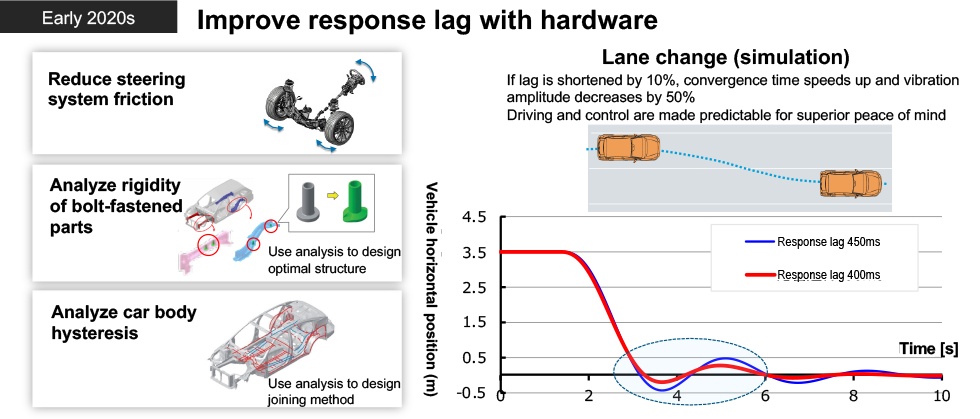
Further improvements are necessary for the following three points: further reduction of steering system friction, nonlinear analysis technology for rational structural design of bolt fastenings that are used to mount engines and suspensions, and analysis of hysteresis across the whole car body. Once we achieve these goals, we should be able to improve car behavior convergence time by 10 percent and vibration amplitude by 50 percent in lane changes. This should enhance ease of driving and peace of mind.
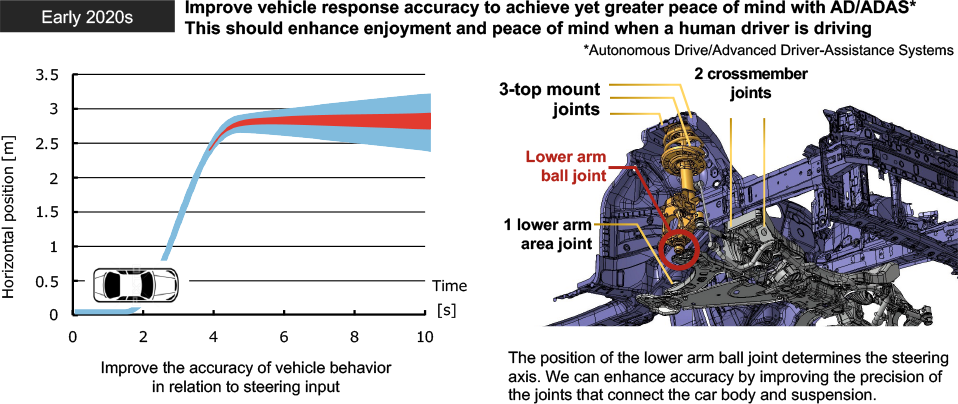
Besides response speed, we also need response accuracy. Vehicles are always required to respond the same ways as drivers input. If they do not, drivers will feel hard to drive since the vehicles go against the driver’s intentions. To improve this aspect, we will further examine and improve the suspension and body precision, in order to make our cars even easier to drive. This should help improve the ride comfort and enhance the driving feel.
High straight-line stability against disturbances

The next aspect is straight-line stability. It is actually quite difficult to make a car drive straight. If it does, it can alleviate driver fatigue. However, on roads in reality, straight-line stability is disturbed by factors such as uneven road surfaces, irregular air currents caused by vehicles such as trucks in front and at the sides, and the air currents caused by the car itself. Therefore, we need technology to measure and analyze these factors. To improve the straight-line stability, we consider that we need more than a wind tunnel and need measurement facility which can reproduce road surface factors.
In cooperation with Catesby Aero Research Facility (CARF) in UK, we are planning to conduct measurements using a 2.74 km straight-line tunnel.
Evolving AWD technology
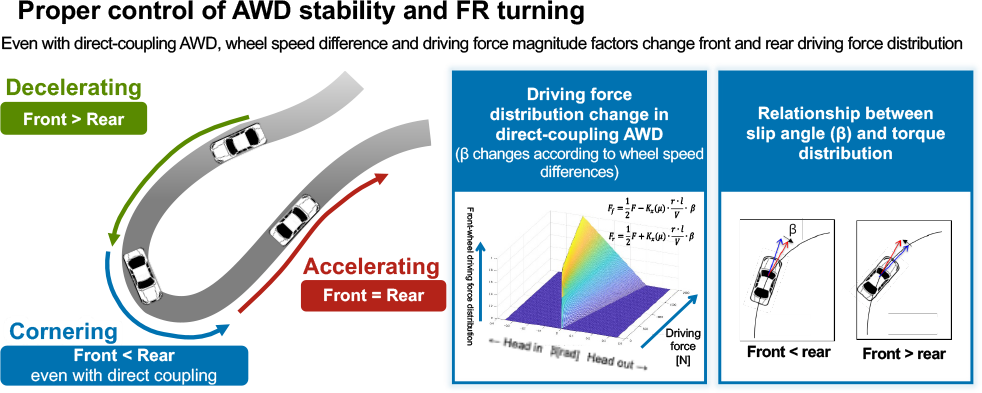
AWD has been the strength of Subaru for so many years, and we will evolve this further. There is a very complex relationship between AWD and driving performance. For example, the front- rear torque distribution is said to be 50:50 in direct-coupling AWD however, the front and rear tires have different rotational speeds in cornering, therefore the torque distribution changes depending on the cornering position. We have figured out that people who are used to driving Subaru cars are able to utilize the characteristics of Subaru AWD to make a turn safely and smoothly. Enjoyment and peace of mind would be enhanced further if everyone could drive our cars in this way. We are developing control technology to realize this.
Honing driving dynamics with a focus on human body structure
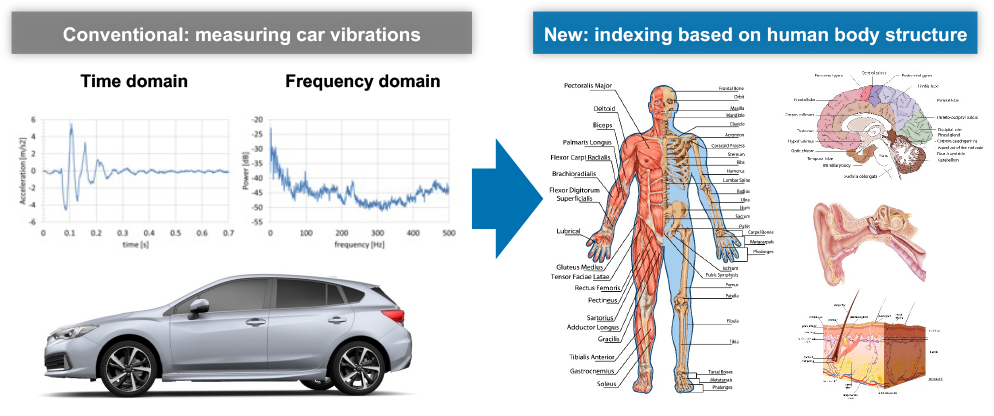
We were inspired to begin the development of the Subaru Global Platform when we noticed that car measurement data did not match the feelings of the passengers in the cars. This led us to reconsider our measurement precision and measurement points, to develop a measurement method whereby the data and feelings would match. This materialized into the Subaru Global Platform. We further advance our research considering human body structure. Some of the results have already been incorporated into recent Subaru cars, but as we continue our research, we will reflect more results in our future cars. By evolving the Subaru Global Platform further, we hope to improve the peace of mind that our drivers feel and the enjoyment of controlling Subaru cars. It will also be a key in the autonomous-driving era. We accelerate to enhance this as an important core technology.
Safety technology to protect people’s lives
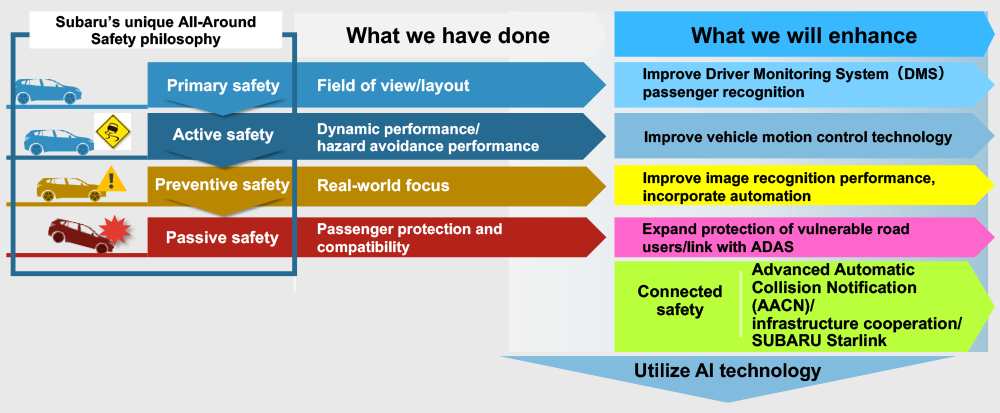
Why does Subaru have a low fatality rate? We believe that this is a result from the vehicle developments based on our philosophy of All-Around Safety. There are four aspects in Subaru’s unique All-Around Safety philosophy: primary safety, driving safety, preventive safety, and passive safety. “Primary safety” means factors such as excellent visibility and fatigue-avoiding packaging. “Driving safety” refers to accurate avoidance performance of objects on the roads and controllability after the avoidance. “Preventive safety” is performances to prevent accidents and to mitigate damages utilizing the features such as pre-collision braking of EyeSight. If an accident occurs even with these three-step measures, we protect passengers in “Passive safety” phase. Third-party evaluations mainly focus on passive safety. Some are starting to cover preventive safety as well. But in Subaru, we consider all four safety aspects, and we think that is why we have lower fatal accident rate in the real world. Henceforth, we plan to continue to enhance our work in each of these four important areas, and to add connected safety. We aim to achieve our goal of zero fatal accidents in 2030 by utilizing AI technologies.
Subaru fatal traffic accident breakdown
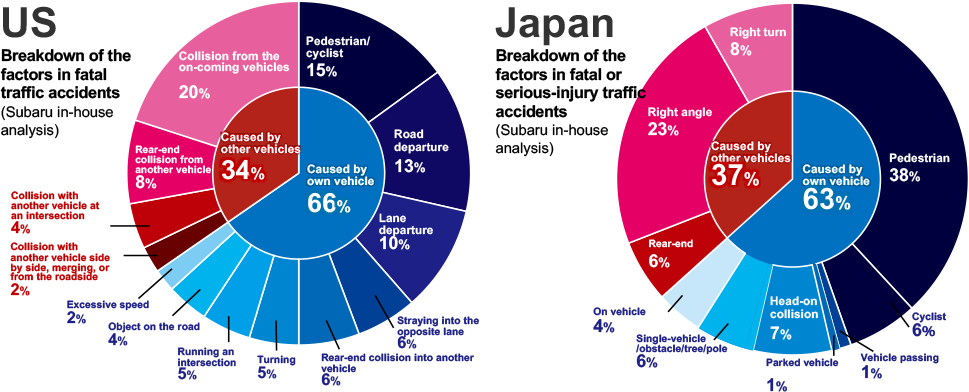
These charts show analyses results of the factors in fatal accidents in the US and fatal and serious-injury accidents in Japan in 2017 involving Subaru cars. The blue parts show accidents caused by own cars, and the red parts show accidents caused by other vehicles. Both in Japan and in the US, 60 to 70 percent of the accidents were caused by own cars.
The scenario heading toward zero fatal traffic accidents
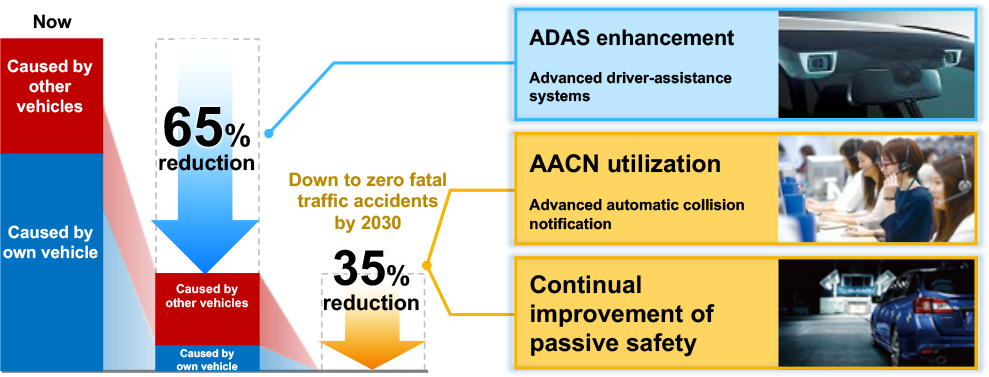
To achieve zero fatal traffic accidents in 2030, first of all, we seek a 65-percent reduction in fatal traffic accidents by enhancement of advanced driver-assistance systems (ADAS). For the remaining 35 percent, we plan to reduce extent of injuries of passengers through continual improvement of passive safety, a Subaru specialty. We also plan to save more lives with advanced automatic collision notification (AACN) using connected services. We expect the combination of these measures will lead us toward achieving zero fatal traffic accidents in 2030.
Enhancement of advanced driver-assistance systems (ADAS)

Regarding advanced driver-assistance systems, very effective in reducing accidents, we will evolve Subaru’s unique EyeSight technology to the next generation. We continue to evolve our system, expanding its response to accidents on local roads, for example, and thoroughly hone accident avoidance and driving support technologies.
Evolution of EyeSight accident avoidance features
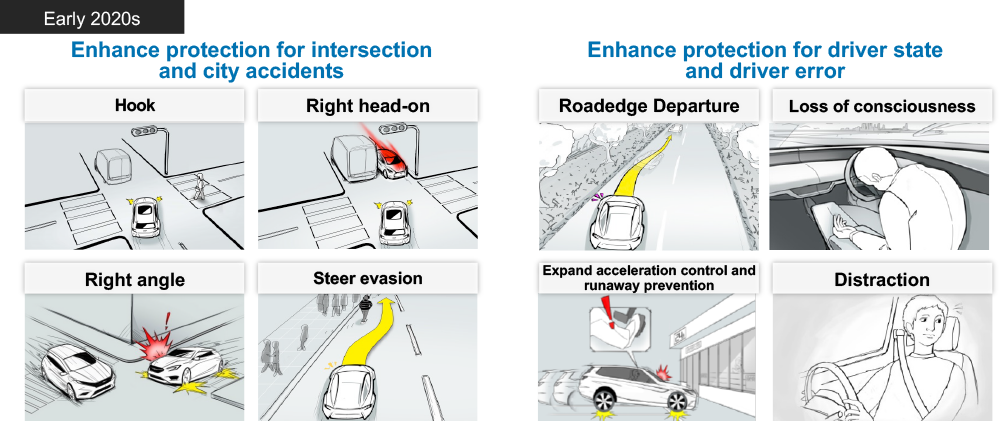
EyeSight has focused on avoiding crashes in straight line driving, but we are now enhancing its protection areas for intersection and city accidents (such as hook accidents involving pedestrians, head-on crashes with oncoming cars during a right turn, and right-angle crashes). We also enhance the system to monitor the state of the driver and to cover the operational errors. We will introduce features to prevent lane departure by recognizing the edge of the road even without white lines and to stop the car safely if the driver loses consciousness.
Evolution of driver-assistance features
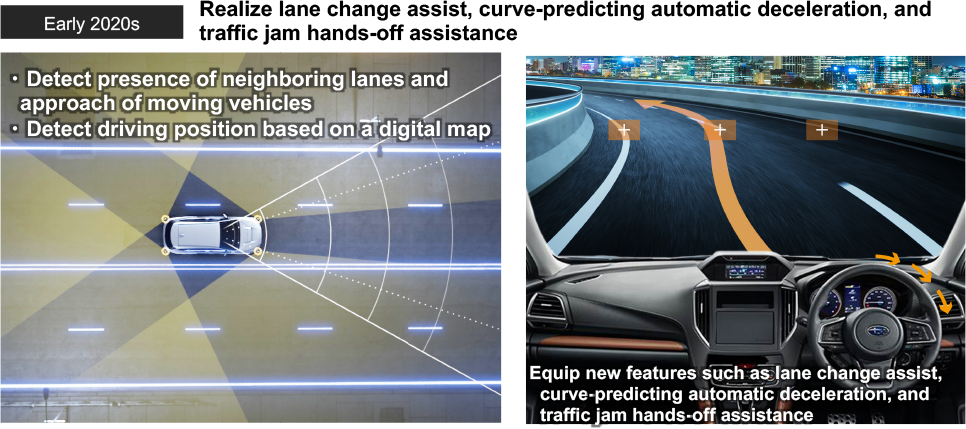
In the next generation of EyeSight, we are combining the stereo camera with a high-precision map locator and four radars in front and rear, in order to hone our driver-assistance technologies that are categorized as Level 2 automated driving such as lane change assist, curve-predicting automatic deceleration, and traffic jam hands-off assistance. We hope to launch cutting-edge features that can realize comfortable and safe highway driving with mass-market cars.
EyeSight: commitment to the stereo camera
Speaking of advanced driver-assistance systems (ADAS), in general, many of them combine radars and a monocular camera. However, Subaru EyeSight uses a stereo camera and a unique recognition algorithm. By capturing everything the camera sees with faithful high precision in three dimensions, EyeSight is able to grasp the shape of objects ahead, measure distances and speeds, and identify their positions.
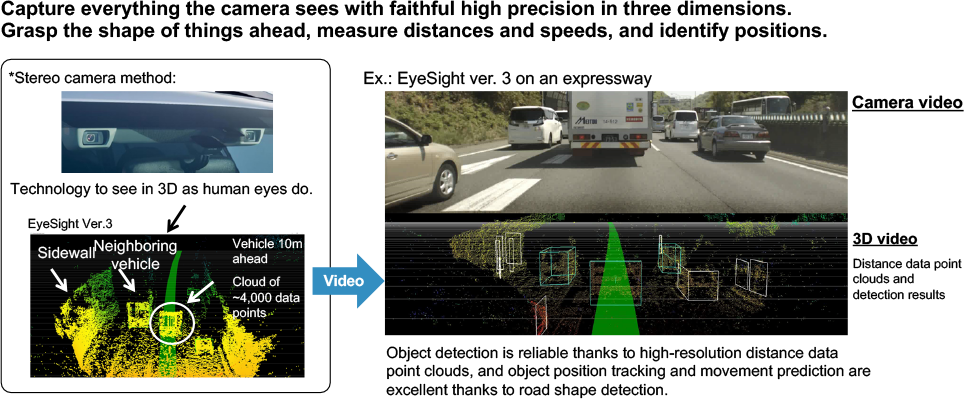
EyeSight is structured to measure distances from the parallax between two cameras. If there is, for example, a car 10 meters ahead, EyeSight recognizes it as a cloud of about 4,000 distance data points. This structure allows for more fine-grained control. EyeSight also excels at road shape detection, object position tracking and movement prediction. Thus, the stereo camera system alone is enough to collect the information needed for recognition and judgment efficiently.
Fusion of stereo camera and AI
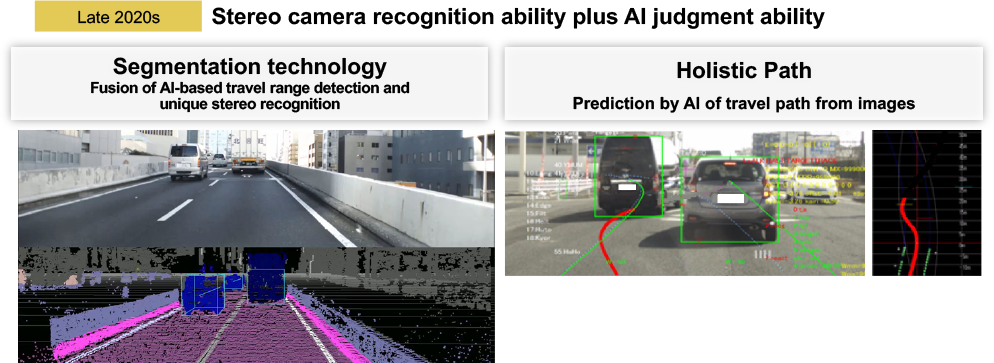
We evolve EyeSight performances to the next level by adding AI judgment ability to the recognition capability.
We can improve the capability to detect drivable areas with the fusion of Stereo camera and AI. For example, one is driving on a snowy road where the center line and road shoulder are completely obscured, AI can calculate drivable areas and figure out the driving route.
Also, if a vehicle in front brakes suddenly and the AI judges that it is impossible to stop, it can find the optimal evasion route and control the car.
Through our research and development to utilize the potential of EyeSight in such ways, we will continue to upgrade its recognition and judgment capabilities and enhance safety on all kinds of roads.
Communicating with your car
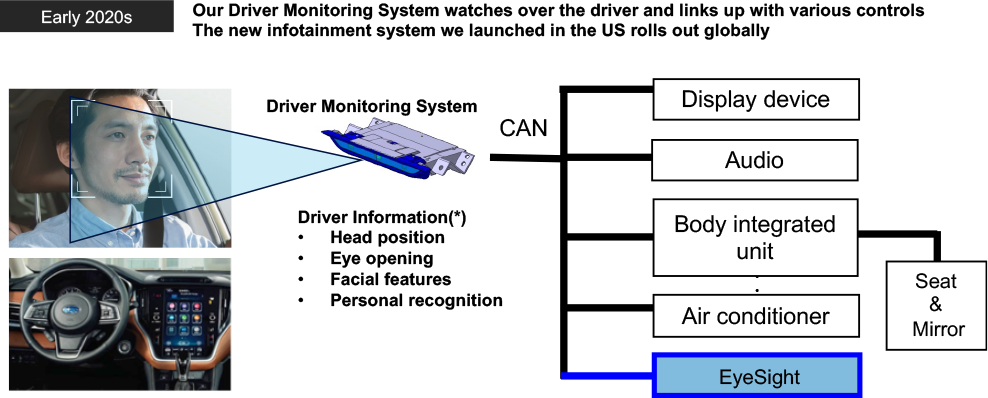
Subaru has adopted a Driver Monitoring System (DMS) since the launch of Forester in 2018. The technology not only recognizes individuals, but also detects driver’s inattentive driving and drowsiness and alerts the driver. We will continue to link up a Driver Monitoring System (DMS) with various kinds of control systems including EyeSight. Also, in 2019, Subaru has released a new infotainment system to the North American market. The amount of data generated by cars is increasing, and so are inputs from such as connected services, as well as things to control. Thus, communication between passengers and cars is becoming more important. Our new system is the first in the world to implement a framework in mass-produced cars that drives important devices such as meters and infotainment features like audios and navigation all in one unit, while taking care of security and reliability. We plan to roll it out globally.
The value of car connectivity
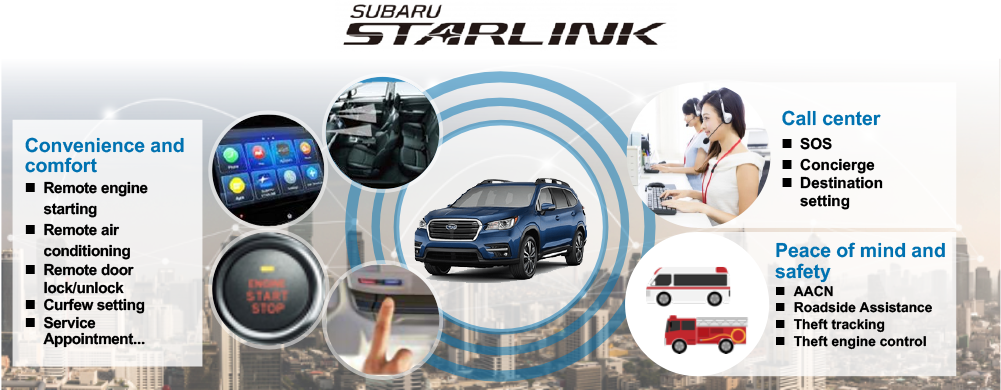
Subaru has been providing the connected services, Subaru Starlink, in the US since 2016.
Enjoyment of connectivity that Subaru provides

This represents the state of subscription to the Subaru Starlink service in the US as of November 2019. Many purchasers of new cars subscribed: 96 percent in the free period for the first three years, an average of 48 percent for paid service. We have in mind to roll this service out in Canada and then in Japan.
Use of advanced automatic collision notification (AACN)
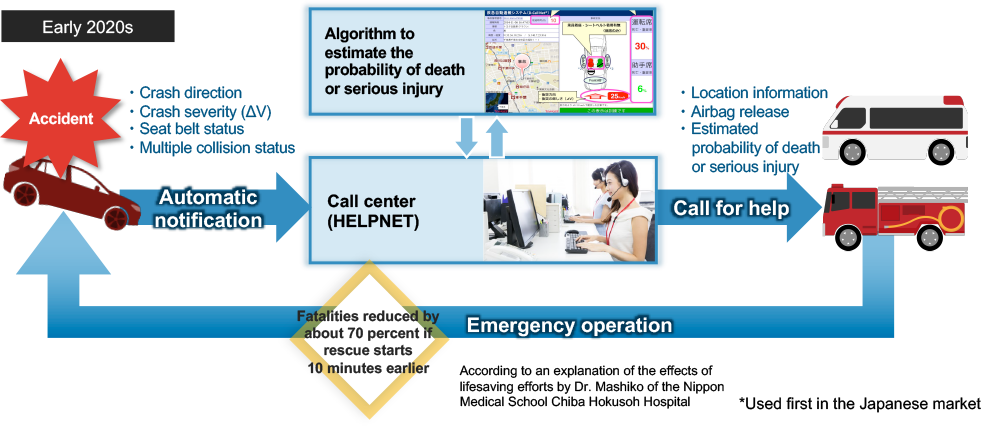
As one element of our connected services, we are rolling out advanced automatic collision notification (AACN) to the Japanese market. This system reports various kinds of data collected automatically to a call center in the event of an accident. It uses an algorithm to estimate the probability of death or serious injury and judges whether an ambulance is needed. If the system judges that it requires an ambulance, it calls for one. Research indicates that fatalities can be reduced by 70 percent if a rescue starts 10 minutes earlier, so we think the system will be important for achieving zero fatal accidents by 2030.
AACN evolution roadmap
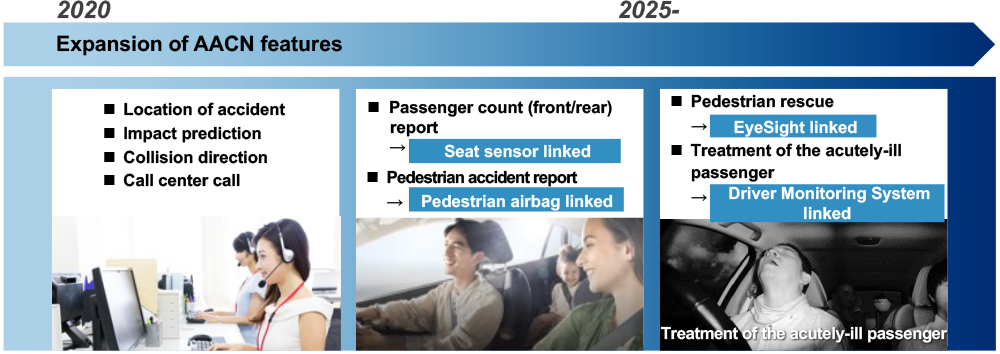
We hope to expand our AACN features even further. We have plans to improve the information precision of our AACN to push up lifesaving rates in accidents: for example, by reporting the number of passengers in the car, by linking with EyeSight to report on pedestrian involvement, or by using the Driver Monitoring System (DMS) to judge and report if the driver is acutely ill.
Continual improvement of passive safety
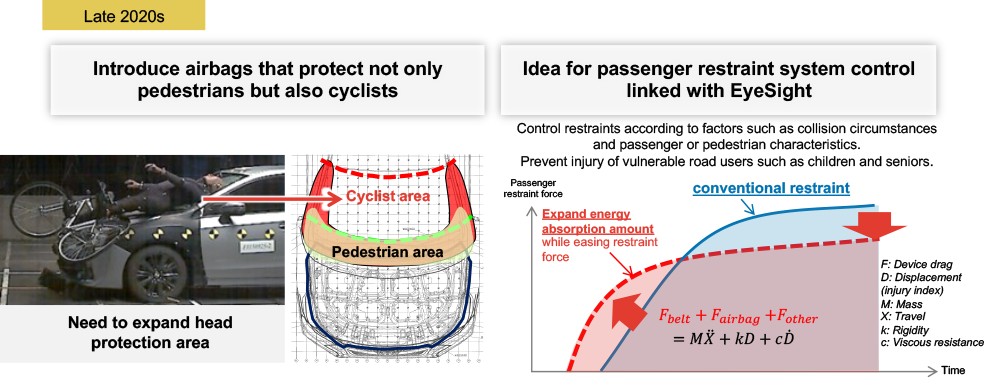
Another key point in achieving zero fatal traffic accidents is mitigating damages by improving passive safety performances. Subaru introduced Japan’s first pedestrian protection airbag in the Impreza released in 2016, but fatal traffic accidents involving cyclists are also on the rise. Our current pedestrian protection airbags have trouble protecting the heads of the cyclists. Therefore, we are studying airbags assuming a crash with cyclists. Also, in regard to passenger protection, our studies have been utilizing passenger injury indices of adult men. But when we looked at actual fatal accident cases, we saw that many cases were involving elder people with weak bones. When we considered how to save them, we have figured out that the keys may be the timing of inflating the airbag and the control of the restraining force of the seatbelt. Now our plan is to further study how fast the airbag can be deployed with EyeSight linkage and how to protect passengers from breaking bones by controlling retaining force of the seatbelts considering ages of passengers monitored through Driver Monitoring System.
In this way, we pursue continual enhancement in the three areas; ADAS evolution, AACN utilization, and passive safety, to realize zero fatal traffic accidents by 2030.
